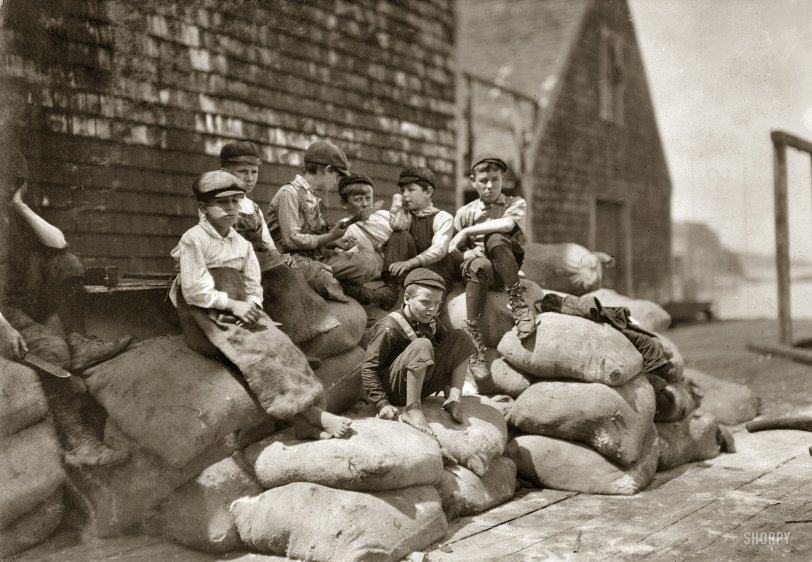


Framed or unframed, desk size to sofa size, printed by us in Arizona and Alabama since 2007. Explore now.
Shorpy is funded by you. Patreon contributors get an ad-free experience.
Learn more.

- Heckuva remote control!
- Sometimes — Things Go Bump!
- I SEE THE LIGHT
- Union Switch and Signal Company
- Get That Light Out Of My Eyes
- Eggs. Eggs. Eggs. The Egg Man is Here!
- Foreboding caption
- Famous Hollywood faces
- Not just S&P
- re: Those things in the jar
- Up In Smoke
- Medical Smoking
- Quick fix
- A Quink Comment
- If You’re Like Me, Never
- Delivering the News
- U.S.A.
- S&P
- 1940 Zenith radio model 6G601
- Quality goes in before the name goes on!
- Snazzy skirt
- Carbon Arc Lamps
- Illuminate us
- I remember it well
- I can't prove it
- Complicated then, forgotten now
- Bryan-Stevenson
- Skinny is as skinny does
- How do you rest in peace
- Riding the footboards
Print Emporium
The Devil's Workshop: 1911

August 1911. Eastport, Maine. "Group of young cutters, Seacoast Canning Co., Factory #2, waiting for more fish. They all work, but they waste a great deal of time, as the adults do also, waiting for fish to arrive." Anyone up for a quick knife fight? Photograph and caption by Lewis Wickes Hine. View full size.
Fast forward
Bare feet, a sharp knife and fish guts. Sounds like a perfect summer day when I was their age --- what a difference 60 years can make.
A Guttin' We Will Go
"And you make sure you wear your "Fish Shoes" when you go a-guttin' young man!" Shoes of the boy on the back right have the toes blown out. Laces look bunchy, like they weren't laced properly; or maybe broken and tied together?
How many of these boys have ADD?? Put a group of this number together today and you'd have bedlam---not to mention, several stabbed children. In my opinion, these attention deficit disorders are something unique to our times.
The Devil's Workshop: 1911
This is Joe Manning, of the Lewis Hine Project. I have tracked down the descendants of 10 of the child laborers that Hine photographed at this cannery. There are 53 of those photos on the Library of Congress website. Among the stories I have posted is one about Elsie Shaw, a six-year-old worker at the cannery. You can see her remarkable story at www.morningsonmaplestreet.com/elsieshaw1.html
Bag it
Wonder what is inside the pile of bags that they are sitting on.
Based on the empty bag in one boy's lap, I suspect they are bags of more bags.
And yes, those are quite some knives for those boys to have. Forget safety scissors with blunt points, these put Crocodile Dundee to shame.
Jets and Sharks
Although they look like a gang ready to fight, they were most likely gutting and prepping sardines, a huge industry in Maine. So many who worked in packing plants lost fingers, either by their own fast knives or by automated cutting machines. In 1948 "Cannery Row" was published about the sardine factories on the West Coast, namely Monterey, but it was not about the working conditions for kids in 1911, more depression era personal stuff. Also I'm guessing they were on "piece work" in which one gets paid for the quantity of his output, not hourly wages. I doubt they would pay anyone for sitting around waiting in 1911. No trophies or self-esteem training for these youngsters.
There but for the grace of God
Ironic that this is titled as it is. When I was a kid in Newark, I knew poverty, but nothing so terrible as this. These "idle hands" were virtual slaves and should be playing ball and reading books. Photos that I see here of people touch me so much more deeply than those of cityscapes and buildings. These fresh, yet forlorn faces say so much, and not one single smile among them. Where are their thoughts taking them? Thanks for these reminders of how good my childhood was.
























On Shorpy:
Today’s Top 5